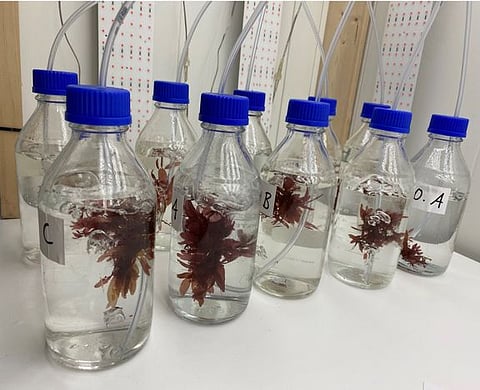

Dulse growing on different concentrations of effluent water from a RAS facility.
Philip James Nofima
Nofima has launched research to produce dulse seaweed using discharge water from land-based salmon production with recirculating aquaculture systems (RAS).
According to the Norwegian Food Research Institute, dulse is a red algae with a relatively high value compared to other macroalgae and is commonly used in food products.
During trials at SalMar's land-based facility, it was found that dulse grew best in 50% RAS discharge water, showed higher efficiency in the removal of ammonia and nitrate, and grew equally well across different salinity levels.
"This underlines the potential for both macroalgae cultivation and utilising RAS nutrients in discharge water as a valuable resource," assured senior scientist Philip James.
Furthermore, the results showed that for every kilogram of fish feed used in RAS salmon farming, 257 grams of dulse could be produced. Therefore, the research team concludes that, considering Norway's land-based salmon industry consumes around 100,000 tonnes of feed annually, large-scale dulse production is a highly feasible scenario.
Finally, in follow-up projects, dulse cultivated in RAS discharge water will also be tested to assess its nutritional benefits and the possible presence of harmful compounds.
This initiative is part of the ValueSøl research project, supported by the Regional Research Fund ARCTIC (RFF), and has been carried out in collaboration with the Norwegian University of Life Sciences (NMBU).
